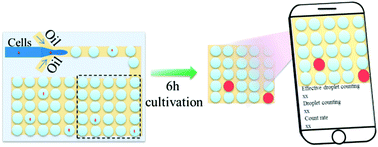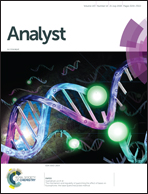Smartphone-based rapid quantification of viable bacteria by single-cell microdroplet turbidity imaging
Abstract
Standard plate count (SPC) has been recognized as the golden standard for the quantification of viable bacteria. However, SPC usually takes one to several days to grow individual cells into a visible colony, which greatly hampers its application in rapid bacteria enumeration. Here we present a microdroplet turbidity imaging based digital standard plate count (dSPC) method to overcome this hurdle. Instead of cultivating on agar plates, bacteria are encapsulated in monodisperse microdroplets for single-cell cultivation. Proliferation of the encapsulated bacterial cell produced a detectable change in microdroplet turbidity, which allowed, after just a few bacterial doubling cycles (i.e., a few hours), enumeration of viable bacteria by visible-light imaging. Furthermore, a dSPC platform integrating a power-free droplet generator with smartphone-based turbidity imaging was established. As proof-of-concept demonstrations, a series of Gram-negative bacteria (Escherichia coli) and Gram-positive bacteria (Bacillus subtilis) samples were quantified via the smartphone dSPC accurately within 6 hours, representing a detection sensitivity of 100 CFU ml−1 and at least 3 times faster. In addition, Enterobacter sakazakii (E. sakazakii) in infant milk powder as a real sample was enumerated within 6 hours, in contrast to the 24 hours needed in traditional SPC. Results with high accuracy and reproducibility were achieved, with no difference in counts found between dSPC and SPC. By enabling label-free, rapid, portable and low-cost enumeration and cultivation of viable bacteria onsite, smartphone dSPC forms the basis for a temporally and geographically trackable network for surveying live microbes globally where every citizen with a cellphone can contribute anytime and anywhere.


 Please wait while we load your content...
Please wait while we load your content...